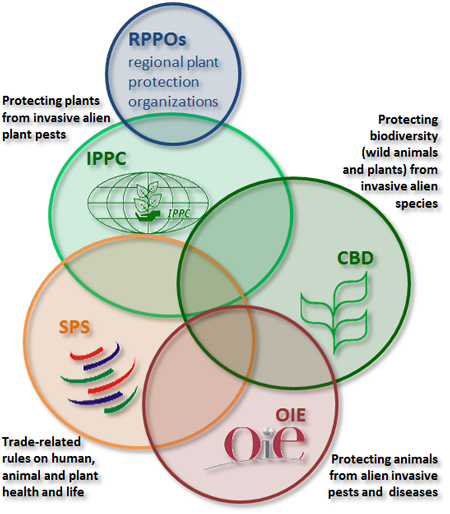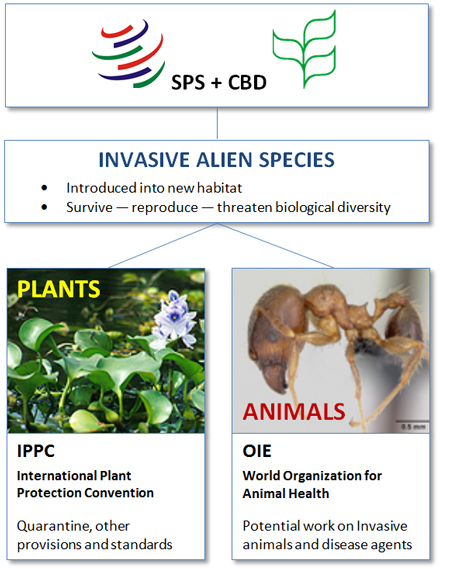NOTE:
THIS NEWS STORY is designed to help the public understand developments in the WTO. While every effort has been made to ensure the contents are accurate, it does not prejudice member governments’ positions.
MORE:
> sanitary and phytosanitary measures
> SPS news
THE SEMINAR
> Programme, presentations and other details
FIND OUT MORE
about SPS’s “three sisters” — the international
standards-setting bodies:
> Codex Alimentarius
> World Organization for Animal Health
> International Plant Protection Convention
The rules, in the Sanitary and Phytosanitary Measures (SPS) Agreement, discipline trade measures on food safety and animal and plant health to avoid their use as an excuse for protectionism — shielding producers from competition from imports, rather than protecting health or the environment. The SPS Agreement does this by requiring measures to be based on a scientific analysis of risk or on recognized international standards.
Those disciplines can be applied to control the spread of destructive animals and plants, the seminar on “International Trade and Invasive Alien Species” was told.
Among the recommendations in a paper presented to the seminar was a call for a decision in the WTO to deal more specifically with the problem and to clarify further how WTO rules apply.
The event was organized by the Standards and Trade Development Facility (a partnership involving a number of international organizations, to help developing countries deal with international standards on food safety and animal and plant health), and two of the three standards-setting organizations recognized in the SPS Agreement, the International Plant Protection Convention (IPPC), and World Organisation for Animal Health (OIE). (The third, Codex Alimentarius, deals with food safety.)
“Alien” species are those that are introduced into new habitats; they are “invasive” if they thrive so much that they threaten biodiversity, which includes agricultural and domestic species as well as wildlife. The threats include competition for food, the spread of disease or the spread of predators. Species that are in balance in one environment can become invasive if they are introduced into another habitat.
Trade is a major means (or “pathway”) in which alien species can be introduced into new habitats. That includes direct trade in the species themselves — for example farm animals or crops, domestic pets or ornamental plants, or the introduction of predators to control pests — or the unintended spread in shipments of goods.
Speakers and discussants described how the problem is being tackled in their countries or regions. Representatives of the private sector, sometimes seen as one of the culprits in the spread of alien species, also described how their industries can contribute to the solution.
Panellists were officials, scientists and non-governmental and industry representatives. They came from national, regional or international organizations such as: the UN Convention on Biological Diversity (CBD); two of the international standards-setting organizations recognized specifically in the WTO’s SPS Agreement, the IPPC (for plants) and the OIE (for animals); the World Health Organization (WHO) and Food and Agriculture Organization (FAO); organizations in the Pacific, Caribbean, North America and Europe; and agencies in the US, EU, New Zealand, Kenya, Sudan, Brazil, South Africa, Indonesia and elsewhere.
‘Desk study’
Some aspects of the relationship between defending food safety and animal and plant health, and protecting biodiversity against invasive alien species is unclear, say Ralf Lopian and Craig Stephen in their “Desk Study” on “International Trade and Invasive Alien Species”, presented at the seminar (available soon on the seminar’s webpage in the STDF website)

Source: Lopian and Stephen, International Trade and Invasive Species
Work on trade rules for protecting plants is starting to take biodiversity and the invasion of alien species into account more specifically, the authors note. In particular, the IPPC, the international standards-setting body recognized in the WTO’s SPS Agreement, takes into account the threat that alien species can pose to plants. Therefore some of its standards and quarantine rules tackle the problem.
The overlap in the scope of the IPPC, the UN Convention on Biological Diversity (CBD) and the WTO’s SPS Agreement can help to produce coherent trade rules for dealing with invasive alien species without being protectionist, the paper says.
Less developed so far are standards or guidelines for dealing with alien animal species, the authors say. The World Organisation for Animal Health (OIE), also recognized by the WTO’s SPS Agreement, focuses almost entirely on the spread of animal diseases. To undertake work on preventing the spread of invasive alien animal species would probably require a decision by the OIE’s members to expand the organization’s mandate, the paper says.
The first step, it says, may be to redefine animal health in a way that specifies the boundaries of the OIE’s involvement in protecting and promoting animal health.
Invasive aliens and SPS standards-setting bodies

The seminar underlined that strengthening SPS capacity is the first line of defense in managing the risks linked to invasive alien species. A number of key actions were identified to control such species more effectively, including:
- boosting continuing efforts to improve the way the relevant international organizations work together, support each other and strengthen each other’s ability to implement the SPS Agreement and global biodiversity conventions
- ensuring existing international standards are implemented better, to prevent trade from spreading harmful alien species — and developing new standards where needed
- boosting countries’ ability to undertake scientific risk analysis and other studies, particularly in developing countries
- improving coordination between ministries and other agencies within countries, between countries and within regions — the agencies’ concerned have diverse responsibilities, from law enforcement, customs and trade to agriculture, fisheries, forestry and environmental protection
- enhancing cooperation between governments and industry
- raising public and political awareness
- studying potential risks associated with the growth in Internet trade, and how to address them
Place the cursor over a term to see its definition:
• sanitary and phytosanitary measures
• S&D, STD, special and differential treatment
> More jargon: glossary
> Problems viewing this page?
Please contact [email protected] giving details of the operating system and web browser you are using.
